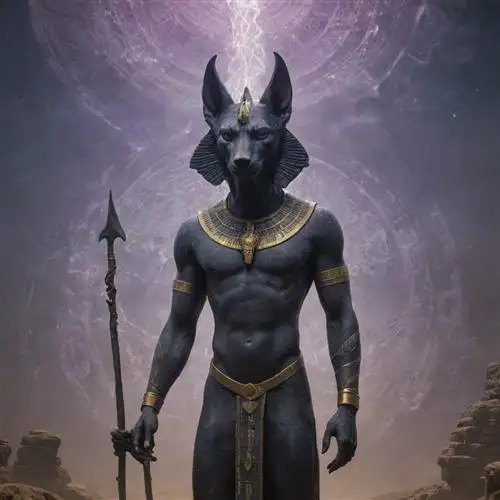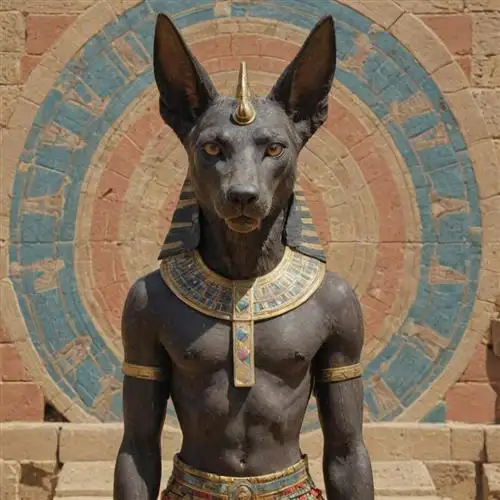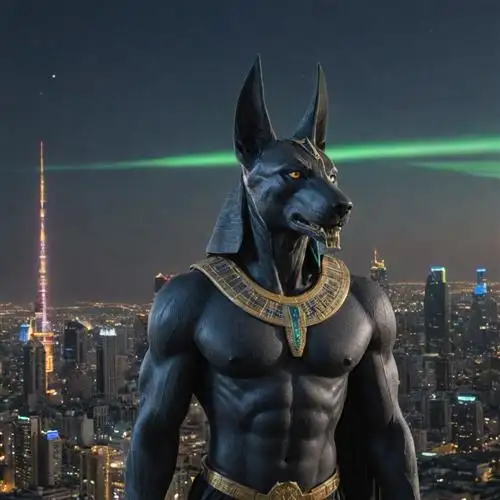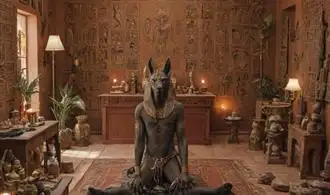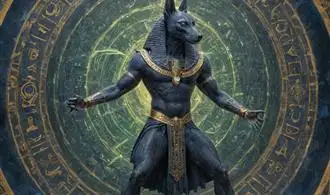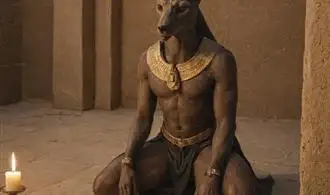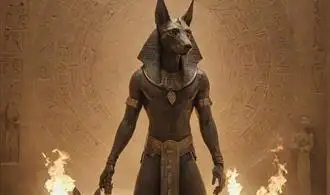
The Ancient Egyptian Roots of Anubis
Anubis, the jackal-headed deity, is a central figure in ancient Egyptian mythology, deeply rooted in the cultural and religious fabric of the Nile civilization. To understand the origins of this enigmatic god, we must delve into the ancient beliefs and practices that gave birth to his enduring legacy.
Scholars suggest that the origins of Anubis can be traced back to the Predynastic period of ancient Egypt, a time before the unification of Upper and Lower Egypt. During this formative era, various local deities and animal-headed gods emerged, each with their own unique roles and symbolic meanings. The jackal, a creature closely associated with the desert and the afterlife, became the physical embodiment of one of these early deities, who would eventually evolve into the Anubis we know today.
The rise of Anubis as a prominent deity can be attributed to his crucial role in the process of mummification and the care of the dead. As the ancient Egyptians developed their sophisticated funerary practices, Anubis emerged as the guardian of the necropolis, the protector of the deceased, and the overseer of the mummification process. His presence was integral to the safe passage of the dead into the afterlife, ensuring the preservation of the physical body and the successful transition of the soul.
The iconography of Anubis reflects his dual nature as both a protector and a guide. The jackal-headed figure, often depicted in a sitting or standing pose, holds the symbolic crook and flail, emblems of royal authority. This representation connects Anubis to the divine kingship, highlighting his role as a mediator between the earthly and the divine realms.
The cult of Anubis was deeply rooted in the ancient Egyptian necropolis of Abydos, a site of immense religious and cultural significance. Here, the god was venerated as the lord of the sacred cemetery, responsible for the safeguarding and sanctity of the burial grounds. Pilgrims and the faithful would travel to Abydos to seek Anubis' blessing and guidance in their journey through the afterlife.
The Symbolic Significance of Anubis
Anubis, the jackal-headed deity of ancient Egyptian mythology, holds a profound symbolic significance that extends far beyond his role as the guardian of the dead. This enigmatic figure represents a complex web of religious, cultural, and metaphysical concepts, woven into the very fabric of Egyptian civilization.
At the heart of Anubis' symbolic importance lies his association with the process of mummification and the journey of the soul into the afterlife. As the god of embalming and the protector of the dead, Anubis was responsible for guiding the deceased through the treacherous terrain of the underworld, ensuring their safe passage to the realm of the eternal. This role of Anubis as a psychopomp, or "conductor of souls," has resonated deeply within the collective consciousness of ancient Egyptian culture, and his influence can be seen in the elaborate funerary rites and practices that have captivated scholars and the public alike.
Beyond his connection to the afterlife, Anubis also holds significant symbolic significance in the realm of transformation and rebirth. The jackal, the animal form with which Anubis is associated, was believed to possess the ability to navigate the liminal spaces between the world of the living and the dead. This symbolic duality imbues Anubis with the power to facilitate the transition from one state of being to another, a concept that is central to the ancient Egyptian understanding of the cyclical nature of existence.
Furthermore, Anubis' role as the weigher of the heart, a crucial step in the judgment of the soul during the afterlife, endows him with a sense of moral authority and divine justice. The weighing of the heart, a ritual in which the deceased's heart was weighed against the feather of Ma'at (the goddess of truth and justice), determined the worthiness of the individual's soul and their ultimate fate in the afterlife. Anubis' presence as the overseer of this pivotal moment in the journey of the soul imbues him with a profound symbolic significance as the arbiter of one's moral and spiritual standing.
The Evolution of Anubis's Worship and Iconography
Anubis, the enigmatic jackal-headed deity of ancient Egyptian mythology, has captivated the minds of scholars and enthusiasts alike. His enduring presence in the pantheon of Egyptian gods is a testament to the complex evolution of his worship and iconography throughout the millennia. From his earliest manifestations as a funerary deity to his later associations with the afterlife, the story of Anubis is one of profound transformation and adaptability.
The origins of Anubis's worship can be traced back to the Predynastic period, where he was primarily venerated as a jackal-like figure associated with the embalming and protection of the dead. This early iconography likely reflects the jackal's natural tendency to scavenge near burial sites, leading to the belief that these canines were guardians of the necropolis. Over time, Anubis's role expanded, and he became a central figure in the Egyptian mortuary cult, responsible for the mummification process and the guidance of the deceased through the underworld.
As Egyptian civilization progressed, Anubis's iconography underwent subtle yet significant changes. While the jackal-headed form remained his most prominent representation, the deity's depiction also incorporated human features, blending the animal and the divine. This hybridization allowed Anubis to embody both the instinctual, primal aspects of the jackal and the rational, administrative facets of the human form. This duality was essential in his role as the overseer of the afterlife, where he would weigh the heart of the deceased against the feather of truth, determining their final fate.
The worship of Anubis was not limited to a single location or temple; instead, his cult was widespread throughout ancient Egypt, with numerous shrines and sanctuaries dedicated to him. This widespread veneration is a testament to the deity's importance in the Egyptian pantheon, as he was revered not only by the elite but also by the common people. The various centers of Anubis's worship, such as Abydos, Cynopolis, and Abusir, each contributed to the evolving iconography and mythology surrounding the deity.
As the centuries passed, Anubis's influence and symbolism continued to expand, with the deity becoming associated with a variety of other Egyptian gods and concepts. His role as the protector of the dead led to associations with Osiris, the lord of the underworld, while his role as a judge of the deceased aligned him with the goddess Maat and the concept of cosmic order. This interweaving of Anubis with other deities and cosmological principles underscores the depth and versatility of his worship, which adapted to the changing needs and beliefs of the Egyptian people.
The Enduring Legacy of Anubis in Modern Culture
Anubis, the ancient Egyptian god of the dead, has maintained a profound influence on modern culture, transcending the boundaries of history and permeating various aspects of our contemporary world. Despite the passage of millennia, this enigmatic deity continues to captivate the imagination of scholars, artists, and enthusiasts alike, leaving an indelible mark on our collective consciousness.
One of the most striking manifestations of Anubis' enduring legacy is his ubiquitous presence in popular media and entertainment. From Hollywood blockbusters to acclaimed television series, the jackal-headed deity has become a staple in modern storytelling. Directors and screenwriters have skillfully woven the mythos of Anubis into their narratives, exploring the complexities of the afterlife, the rituals of mummification, and the profound mysteries surrounding death and the beyond.
In the realm of visual arts, Anubis has inspired countless creatives to reimagine his iconic form, breathing new life into this ancient symbol. Painters, sculptors, and digital artists have reinterpreted the god's visage, infusing it with their unique artistic styles and contemporary sensibilities. These interpretations not only pay homage to the rich cultural heritage of ancient Egypt but also serve as a testament to the enduring power of Anubis to captivate and inspire.
The influence of Anubis extends far beyond the confines of the entertainment industry and the art world. In the realms of archaeology and Egyptology, the study of this enigmatic deity continues to yield fascinating insights, shedding light on the intricate web of beliefs and practices that defined ancient Egyptian society. Scholars and researchers delve into the iconography, mythology, and ritual significance of Anubis, uncovering new layers of understanding and fueling ongoing discussions about the role of the divine in the ancient world.
Additionally, the enduring fascination with Anubis has given rise to a thriving subculture of devotees and practitioners who seek to honor and connect with this powerful deity. From neopagan and occult movements to specialized academic and enthusiast communities, the worship and veneration of Anubis continue to evolve, adapting to the changing needs and perspectives of modern times.


